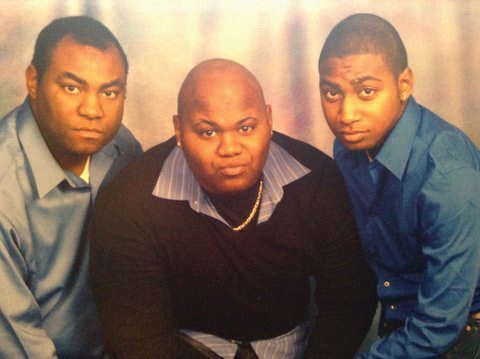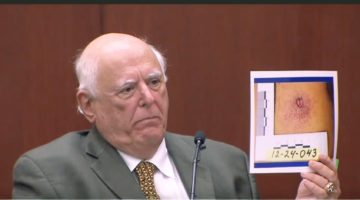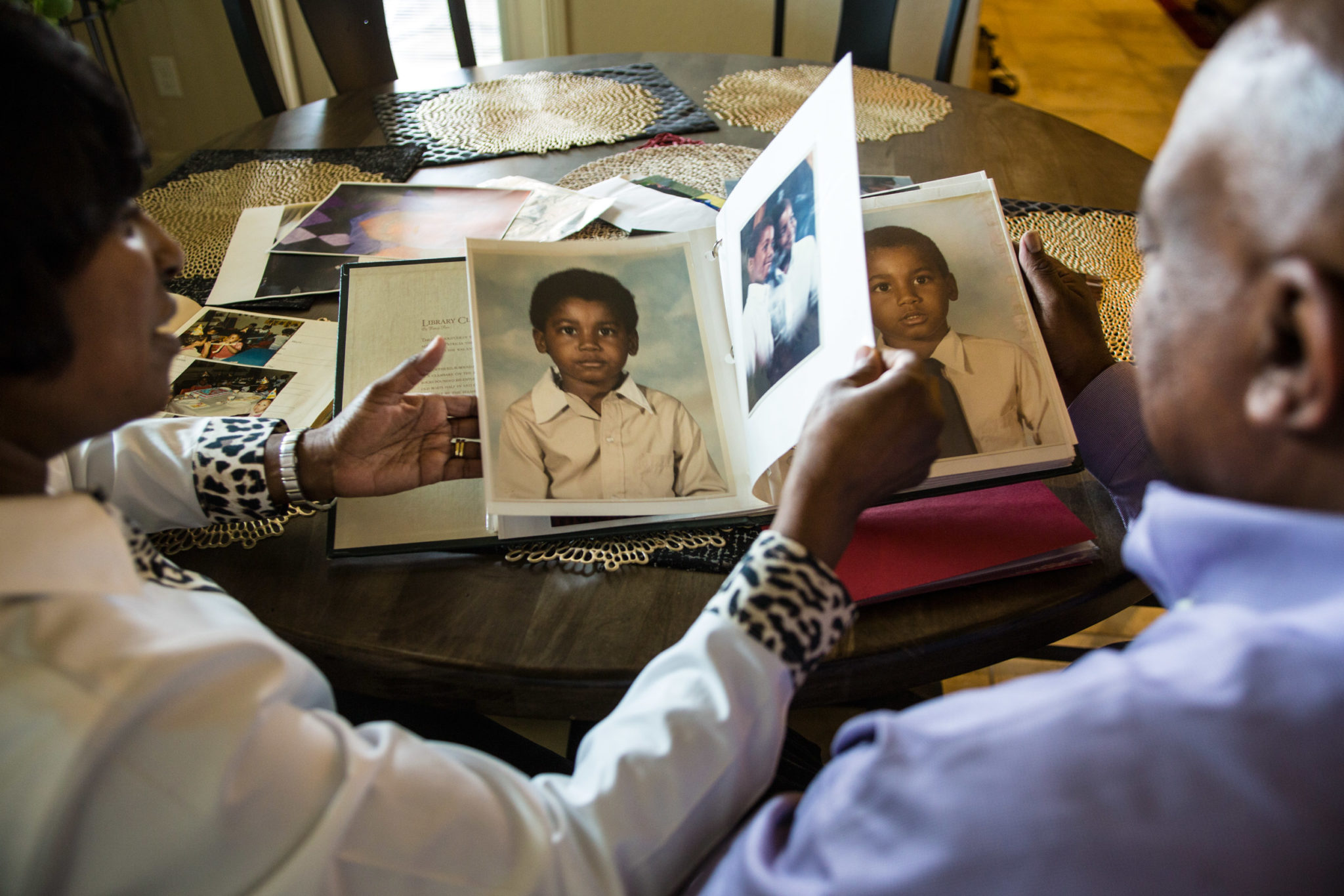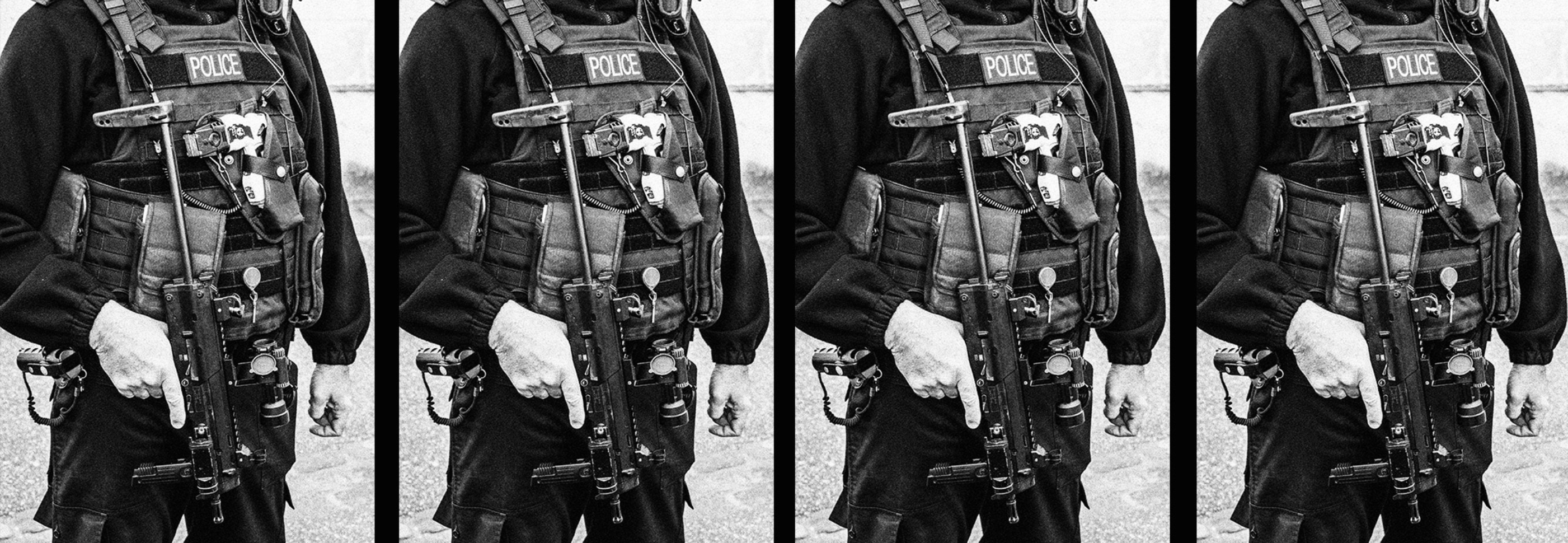Content warning: This story details police violence against a Black individual.
When Jennifer Cooper looked down at her phone at 2 a.m., she was surprised to see she had missed texts and calls from two of her sons. The phone had been on silent mode while Jennifer and her husband, Noble, finished up a church retreat in the East Texas woods, a four-hour drive from their home in northeast San Antonio. Why would the boys call so late?
Jennifer didn’t really understand the first message, from her middle son, Norman. Before his parents left town that week, Norman, 33, had argued with his wife, Carly — he came home too late one night, they fought, and he agreed to stay somewhere else for a couple of days to let things cool off, according to family. Now Norman was upset, texting his mother to say he’d been “locked out of the houses.”

The second text scared Jennifer. It was from her youngest son, Nate, who was visiting San Antonio for work and had agreed to watch the house for his parents while they were away. Norman had shown up and was acting so strange it made Nate nervous. Cell reception was bad at the hotel and Jennifer couldn’t get through to either of her sons. By the time her husband got Nate on the phone, he’d already called the cops.
Nate says Norman arrived at the house, the morning of April 19, 2015, yelling and pounding on the door. When Nate opened it to let him in, Norman pushed his way through before his brother could undo the chain lock, ripping off a chunk of wood from the doorframe. Nate says Norman paced and flipped the lights off and on. He figured his older brother was high, but didn’t know on what. (Authorities later found methamphetamine in Norman’s system.) There was something vacant about Norman’s eyes that made Nate nervous. “Like he was looking through me,” Nate says.
He’d seen his older brother like this once before, about a decade earlier, when Nate was in high school. Police arrived, talked Norman down and eventually took him to the hospital. Carly, who’d been with him since they were in high school, remembers the episode being “actually a positive thing for Norman. He got whatever help he needed.”


The family assumed something similar would happen when they called police for help that morning. Norman was sweaty, shirtless and standing in the hallway, half-shouting, half-preaching to his brother about Jesus and rambling about the evils of internet porn, when San Antonio police officer Oliver Flaig entered the house. Norman yelled at his brother to heed God’s word. His voice, captured by a police audio recording of the scene, delivers the words with rhythm, almost like he’s singing.
At first, Flaig tried to reason with Norman, but he quickly lost patience. Minutes later, the officer told Norman to “shut the fuck up.” Within five minutes of being on the scene, Flaig had heard enough and began shouting at Norman to get his ID. Norman said it was upstairs, so Flaig and another officer who’d arrived as backup, Arnoldo Sanchez, followed him to the second floor. When they ordered him to put his hands behind his back, Norman again called his mother, who this time picked up.
When officers arrived at the Cooper residence, Norman was singing, shouting and preaching.
Jennifer winces when she describes the mechanical clicking sound of the Tasers that punctuated her son’s final words. Court records show that 11 minutes after police arrived, Sanchez was the first to shoot Norman with his stun gun. Over the course of three minutes, the officers shocked Norman a total of nine times, shooting a 50,000-volt current through his body for nearly a minute total. Autopsy records show Norman was hit by four pairs of barbed darts that, via insulated copper wires, connected him to the ubiquitous “less lethal” law enforcement tool. In other words, both officers fired their Tasers, loaded their backup cartridges and fired another set of darts during the encounter. Two of them hit Norman in the lower back.
Over the course of three minutes the officers shocked Norman a total of nine times, shooting a 50,000-volt current through his body for nearly a minute total.
Four minutes after the Tasers stopped, the officers discovered Norman’s heart wasn’t beating. Emergency responders couldn’t restart it and, an hour after his brother first called police for help, officials pronounced Norman dead. A minute later, another officer offered his theory: “excited delirium.” His tone made the explanation sound obvious.
Excited delirium syndrome, as it’s officially known, is an old theory with roots in the insane asylums of the mid-19th century. It was first used to explain why hospital staff weren’t to blame for crazed patients who died for sudden and unexplained reasons. It eventually morphed into a diagnosis with symptoms seemingly ripped from the pages of the era’s most famous split-personality tale, The Strange Case of Dr. Jekyll and Mr. Hyde.
Proponents of the diagnosis say that for people in the throes of excited delirium — nowadays usually those high on cocaine or meth — it’s like a switch has been flipped, producing someone agitated, combative and even impervious to pain, pepper spray or stun guns. They sweat profusely and sometimes start to shed their clothes. And then their heart stops, often stumping coroners who can’t find a distinct, anatomical cause of death.
Thanks in part to Vincent Di Maio, a former San Antonio medical examiner turned celebrity scientist, it’s a diagnosis police know well. Over the years, cops and their defenders have come to use excited delirium to explain why people have died after being choked, hog-tied, pepper sprayed or shocked by stun guns during police encounters.
An assistant medical examiner in Bexar County wrote that Norman Cooper’s heart stopped as a result of the meth in his system “complicated by a prolonged struggle” with police, ruling the death a homicide. For violating department rules on Taser use, the San Antonio Police Department (SAPD) gave both officers written reprimands, an official slap on the wrist that carries no other punishment. Two months later, the department changed its Taser policy so that other officers won’t be disciplined for the same actions.
Over the years, cops and their defenders have come to use excited delirium to explain why people have died after being choked, hog-tied, pepper sprayed or shocked by stun guns during police encounters.
After the Cooper family filed a federal lawsuit against the officers, claiming their negligence led to Norman’s death, a forensic expert hired by the city of San Antonio found a different cause: “an excited delirium due to methamphetamine intoxication occurring in the setting of a violent struggle with law enforcement.”
Excited delirium has long been a controversial diagnosis. While it’s recognized by the National Association of Medical Examiners and the American College of Emergency Physicians, it’s not listed in the American Psychiatric Association’s diagnostic bible, the Diagnostic and Statistical Manual of Mental Disorders. Nor is it recognized by the American Medical Association, which has long stated it has “no official policy” on the disorder. Critics call it an official best guess and a convenient way to excuse police actions that led to someone’s death.
Brant Mittler, a cardiologist and medical expert hired by lawyers representing the Cooper family, says Norman’s death is a tragic example of how excited delirium can be used not only to shield cops from liability in someone’s death, but also to blind entire departments from the seriousness of officers’ mistakes. How often the diagnosis is invoked by police isn’t entirely clear. Only recently have states, including Texas, begun passing stricter reporting requirements for deaths in police custody. Sometimes, the diagnosis doesn’t officially appear until there’s a lawsuit.
Officers Flaig and Sanchez shocked Norman nine times, according to court records. At one point, both officers shocked him at the same time. In his report, Mittler writes that no one even started CPR on Norman until around 15 minutes after his heart stopped.
“I truly don’t think it exists,” Mittler says of excited delirium. “But it has been brilliantly used by police departments to explain why they’re not the ones killing people.”
Nate was still downstairs and on the phone with his father when he heard the police scuffling with Norman above him. Jennifer tried shouting at the officers through the receiver. She says that at one point she grabbed her husband’s phone and told Nate to deliver a message to the officers: “Tell them to please stop Tasing my baby.”
Nate says that when he walked upstairs, Norman was “on the floor gasping for air,” with his hands cuffed behind his back and an officer kneeling on top of him. He thinks he saw them shock his brother at least one more time before his body went limp.
By then, other officers were starting to arrive. Nate remembers one who walked into the room where Norman was lying on the floor, unresponsive, and shined a flashlight into his eyes. “He’ll be fine,” she said. The other officers made fun of her: “Oh, so you’re a doctor now, huh?”
“That bothered me for the longest time,” Nate says. “I was, like, shaking. And they were just in there joking.”
Officer Flaig describes the encounter with Norman to an unnamed investigator, who calls it a case of “excited delirium.”
Vincent Di Maio is to excited delirium what Galileo was to telescopes: He didn’t invent the thing, but he showed the world how to use it.
In 2006, Di Maio co-wrote a widely cited textbook on the syndrome with his wife, Theresa, a forensic nurse who worked in San Antonio’s mental health facilities. On the first page, they dedicate the book to “all law enforcement and medical personnel who have been wrongfully accused of misconduct in deaths due to excited delirium syndrome.”
Di Maio, a pathologist whose expertise is often deployed in sensational, headline-grabbing cases, is likely the syndrome’s most high-profile and influential evangelist. A decade after he penned the textbook, the former longtime chief medical examiner of Bexar County teamed up with a crime writer for an autobiography, Morgue, that highlights his greatest hits, including exhuming and studying the body of JFK assassin Lee Harvey Oswald.
Di Maio sprinkles observations on race throughout the book. He writes how early in his career, a grisly case introduced him to the “full-fledged black power movement that promoted violence against racist white society.” During a fellowship with the Maryland medical examiner’s office in 1970, Di Maio examined the remains of two black activists with the Student Nonviolent Coordinating Committee who were dismembered when a bomb exploded near the floorboard of their car. Di Maio’s work bolstered what would become the official theory: The men died when a bomb they were transporting detonated prematurely.
Others, including U.S. Representative John Conyers Jr., a Michigan Democrat, suspected officials were covering up an assassination attempt. Di Maio writes that his work debunking the theory helped quell racial unrest that would “make the riots in Watts and the nationwide anarchy after the King assassination look like prayer vigils.”

Di Maio has a knack for making young black men look worse in death. He was instrumental in George Zimmerman’s acquittal, offering testimony that was key to a defense theory that painted Trayvon Martin as the aggressor. According to Di Maio, a pattern burned into Martin’s clothing and skin by the bullet that killed him proved Martin was leaning over Zimmerman at the time he was shot. In his book, he accuses President Barack Obama of fueling outrage over the case and grouses that “Reverend Al Sharpton and the rest of the racial-grievance industrial complex showed up to stir the pot.”
He flatly rejects the idea that the killing raises larger questions about racial profiling. “It was a simple case,” Di Maio told the Observer. “The news media inflamed it and made it a racial thing when it was not.”
Di Maio similarly dismisses the criticism aimed at excited delirium, calling it a medical phenomenon documented for more than 150 years.
Di Maio traces the syndrome all the way back to 1849, when Luther Bell first described patients at his Massachusetts insane asylum dying in restraints during an episode of “exhaustive mania.” What was labeled “Bell’s Mania” eventually took on other names, such as “acute maniacal delirium” or “lethal catatonia.” In their book on excited delirium, the Di Maios contend that the syndrome all but disappeared for a while as mental hospitals in the mid-20th century embraced sedatives, such as Thorazine, that kept it at bay.
By the 1980s, however, medical examiners in Miami reintroduced the concept to the general medical community as cocaine flooded South Florida and crazed, coked-up people started dying for unclear reasons, often after a struggle with police. In an academic paper published last year, University of Miami neurology professor Deborah Mash writes that excited delirium is something people appear to be genetically predisposed to. Mash, who has become the leading brain researcher on the subject, argues that due to bad wiring, the brains of some people who get high on stimulants or suffer acute manic episodes basically flood with excess dopamine. The reaction triggers what she calls “cardiorespiratory collapse.”
“These people aren’t dying because of police,” Mash says. “It’s a brain disease. People don’t act out in these very bizarre manners that police describe without an underlying brain disorder. Plenty of people abuse cocaine and never develop excited delirium.”
Critics, however, call excited delirium a barely understood medical phenomenon that, even if real, has been stretched to cover police conduct that sometimes kills people.
Douglas Zipes, an Indiana University cardiology professor emeritus, learned of excited delirium when Taser International, the company now known as Axon, started to introduce it in court to defend how police use their stun guns. In the past, Taser has hosted seminars and sent out pamphlets on excited delirium to police and medical examiners’ groups across the country; sued medical examiners who listed their stun guns as a cause of death; and even gave law enforcement agencies a ready-made statement for when someone dies after police shock them with a stun gun: “We regret the unfortunate loss of life. There are many cases where excited delirium caused by various mental disorders or medical conditions, that may or may not include drug use, can lead to a fatal conclusion.”
Mash acknowledges that the company has paid her for expert testimony. On the other side is Zipes, who, after years of examining custodial deaths for grieving families that wanted to sue police departments, calls excited delirium a “last-ditch, wastebasket diagnosis” that only appears to be widely used in a law enforcement context.
Zipes says that about once a month he gets a call from a family or lawyer asking him to look into a death that police attributed to excited delirium. In some deaths, the medical examiner will actually list it as the cause. The Austin American-Statesman recently used custodial death reports from the Texas Attorney General’s Office to show that cops across Texas have cited excited delirium in at least 50 deaths over the past decade. Zipes suspects that’s a conservative estimate, since some, such as Norman Cooper, won’t officially get the diagnosis unless their deaths become court cases.
“I truly don’t think [excited delirium] exists. But it has been brilliantly used by police departments to explain why they’re not the ones killing people.”
Zipes worries about how broadly police and medical examiners apply the diagnosis. He says some pathologists spin theories based on how officers at the scene described a dead person’s behavior. “We are talking about a cause that does not exactly leave footprints in the body when the organs are studied,” he said. “The medical examiner makes this diagnosis after they rule everything else out and read the history of what police said. That’s inappropriate from a scientific standpoint as far as I’m concerned.”
In their book, the Di Maios claim that they’re challenging the underlying assumption that police have done something wrong when someone dies after a struggle. They lament how deaths in police custody often lead to “hasty, inflammatory and unsupported accusations of wrongful death by families of the deceased, attorneys and the press.” They also explain why deaths attributed to choke holds, pepper spray and stun guns should be scrutinized for signs the suspect actually died from excited delirium.
Di Maio says he urges law enforcement agencies to respond to excited delirium like a medical emergency rather than a criminal matter, the idea being that immediate medical attention, such as sedation, can sometimes keep the brain from short-circuiting. But he also says excited delirium acts like a switch in the brain, and once you flip it, there’s no going back. “Once you go into excited delirium, you’re a goner,” he said. The rub, of course, is how to train officers to appropriately respond to a syndrome that they’re told is likely already fatal by the time they recognize its symptoms.
On the evening of April 12, 2013, as they drove around San Antonio’s west side, Dominique Martinez told Jesse Aguirre she wanted to break up. Aguirre had entered a tailspin when, not long after his brother died, his mother came back from the hospital one day with a diagnosis of terminal cancer. Martinez later told police that Aguirre had become suicidal and started binging on booze and cocaine.
Aguirre, according to court records, didn’t take the breakup well: He threatened to kill himself and take his girlfriend with him. Martinez tried to grab the steering wheel as Aguirre punched the gas pedal and the car jumped a curb, crashing into a chain-link fence. She told police Aguirre was “acting crazy” and said he bolted from the car, running south toward a busy highway. Officers who encountered him said he was “irrational” and shouting about being hunted by the Bandidos biker gang. Witnesses saw him hopping between lanes as cars whizzed by.
Police video shows Aguirre walking in the middle of the highway, near the concrete median, as officers approach him. When he stops, they yank him over the concrete barrier, his body almost folding in half, before flipping him onto the other side of the highway and placing him face-first on the hood of a cruiser. Police later claimed Aguirre resisted when they tried to move him to a car, which is why they pulled him off the hood and forced him to the ground on his belly. Video shows one officer bending Aguirre’s legs up and over his body while others pin him to the ground for more than five minutes. The only obvious resistance Aguirre shows on video is when he moves his head from side to side. Then his body goes limp.
Aguirre’s family argued in a lawsuit against the city and the officers that police treated him “as if they were tossing around a ragdoll instead of a human being.”
In an expert report filed in federal court last year, Di Maio called Aguirre’s death a textbook example of excited delirium triggered by cocaine. But did the cops’ rough handling of Aguirre contribute to his death? After all, they’re told to recognize excited delirium as a medical condition.
Death Has Many Names: the Evolution of Excited Delirium
In his own report, Brant Mittler concluded that the SAPD officers made serious mistakes that led to Aguirre’s death, including the use of restraint techniques the U.S. Department of Justice has cautioned against for two decades due to the risk of asphyxiation. Mittler contends that, at least in part, a lack of oxygen from the prolonged struggle and the way police restrained Aguirre made his heart stop.
“Nobody’s going to look at deaths like Aguirre and Cooper and say, ‘Should we do things differently?’ That’s what I’m afraid of.”
As part of their mandatory 40-hour education on responding to people in psychiatric crisis (so-called Crisis Intervention Training), the officers who restrained Aguirre were trained on excited delirium, including how to recognize the symptoms, de-escalate the situation and avoid a prolonged police struggle. Mittler says the case shows how police only seriously consider excited delirium a medical problem after someone’s already dead.
“I am not agreeing that [excited delirium] is a real syndrome,” Mittler wrote in his report on the Aguirre case, “but if it does exist, the SAPD officers involved appear to have violated all the warnings and admonitions advised to treat it and prevent death.”
In May, federal District Court Judge David Alan Ezra dismissed the lawsuit against the city and the officers involved in Aguirre’s death, saying there’s no evidence that police knowingly violated his constitutional rights or willfully disregarded his medical condition.
Ezra chastised the family’s claims as “lacking clarity and poorly organized.” He concluded the officers responded to a “tense, uncertain and rapidly-evolving” situation the best way they knew how and wrote that their split-second decisions “will not be second-guessed.” He also noted that the debate over excited delirium had effectively muddied the waters: “Additionally,” Ezra wrote, “where Dr. Mittler admittedly cannot even determine whether [excited delirium] is a ‘real syndrome,’ none of the officers can be charged with deliberate indifference to a medical condition that may or may not exist.”
Mittler worries there’s little reason for police to question how they restrain people like Aguirre if they can just pin their deaths on the modern-day version of Bell’s Mania: “Nobody’s going to look at deaths like Aguirre and Cooper and say, ‘Should we do things differently?’ That’s what I’m afraid of.”


Jennifer Cooper says that when Norman was young, people at church told him he would one day preach the gospel. He’d come home beaming with pride whenever someone delivered the prophecy. She suspects that’s why he knew the Bible so well. Jennifer would recite verses when she scolded her boys. “Norman would throw them right back at me,” she says. “Sometimes he’d finish my scriptures for me.”
When she thinks of Norman’s final words — Thank you, Jesus — certain verses come to mind. She lingers on Proverbs 18:10: The name of the Lord is a strong tower. The righteous run into it and are safe. She thinks Norman was calling out for protection, just like they taught him at church.
Lawyers for the Cooper family, Ed Piña and Matt Gossen, argue that police had no reason to shock Norman with Tasers that morning — especially not nine times. In the audio recording of the encounter, he never threatens the officers, who start to lose patience as Norman ignores them and keeps yelling and preaching. In a low, stern voice, like he’s saying it through his teeth, one officer repeats “Get on the ground” moments before the first Taser blast. Norman keeps calling them “sir” and “officer,” even after the stun guns start.
“Sure he was acting funny, but that shows me he was still trying to be respectful to the police,” his father, Noble, says.
“They should have de-escalated the situation,” Piña says. “Norman had done nothing to warrant that kind of force.”
In his report on Norman’s death, Mittler says the Tasers paralyzed Norman’s muscles, including his diaphragm, in intermittent bursts. His body couldn’t replace the carbon dioxide building up in his blood with new oxygen. That, combined with an underlying heart condition, in turn led to a fatal heart attack, according to Mittler.
Content warning: In this audio clip, police deploy their stun guns against Norman Cooper while he is praying. Cooper died as a result, and his death is captured in this audio. Please listen with caution.
After Norman’s death, officers Flaig and Sanchez received written reprimands, the lightest punishment possible, for violating department policy that prohibits using stun guns on anyone “known to be under the influence of drugs.” In 2008, after a wide-ranging review of the department’s use-of-force policies, San Antonio Police Chief William McManus implemented it as a reform to prevent needless in-custody deaths. Piña thinks Norman’s case might be the only time in recent years that San Antonio cops were disciplined for force used during an in-custody death.
The department changed that policy two months after Norman died, tweaking the language from “shall not” to “should not.” In an email obtained by the Observer, SAPD Assistant Chief James Flavin tells an investigator at the Bexar County District Attorney’s Office the change was made “in order to allow officers the opportunity to evaluate all the information they received at the scene” before deciding whether to deploy a Taser. The reformed Taser policy heralded by the chief, he writes, was always in conflict with the department’s actual training practices. For emphasis, the captain underlined the part that says, “The SAPD Training Academy and its instructors have never taught officers that they shall not use an ECD (Taser) on persons known to be under the influence of drugs.” (He even bolded the word “never” in case the point wasn’t clear.)
SAPD didn’t respond to the Observer’s questions about its Taser policy or Norman Cooper’s death. Lawyers for the city say in court filings that it was caused by Cooper’s drug use and health problems, not by any action police took that morning. Piña argues that the department grudgingly disciplined two officers for violating a policy they’d never been trained on in the first place, only to turn around and change the policy so that other officers wouldn’t be punished for it in the future.
Jennifer thinks of another verse when she remembers the sound of her son’s last moments over the phone. It’s another one from Proverbs: Train a child up in the way he should go, and when he is old he will not depart from it. “No matter what situation he found himself in, no matter where his head was at, that faith was still in him,” she says. Her son’s final words, at least, were proof of that.




